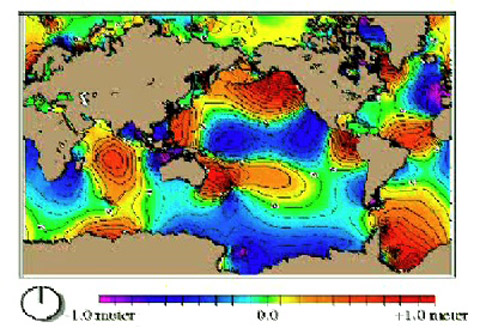
Ocean tides: differences between theory and reality.
In the current theory on tides there are at least four points which, if considered individually, and even more so if considered together, are not consistent with reality.
========================================================
index tides ||| © copyright notice
========================================================
It is a fact that the Moon has the greatest effect on the tides. For 330 years they have wanted to attribute this phenomenon to gravity, to the cost of changing the relative formula, raising the distance to the third power, instead to the second power.
It has been a while since I found this attribution in clear contrast with four facts.
1a - The formula valid for the tides in the current theory.
According to the current theory, in the formula of gravitation, to be applied only to the tides, the distance is elevated to the 3rd power, and not to the 2nd power.
So that the respective contributions to the tides, by the Moon and the Sun would be: Sun 1, Moon >2.19.
Instead, if we raised the values of the distances only to the 2nd power, so abiding by the law of attraction, we would have the following average ratios:
Sun 1, Moon 0.0056;
equivalent to: Moon 1, Sun 178.
They claimed this was an exception, as if it were possible for gravity to operate differently in the case of tides.
1b - Attraction ratio.
By the way, what could be the effect of the attraction of the Moon, on the waters of the oceans, when it is one / nine millionths of that due to the mass of the Earth?
Quite astounding if the attraction could produce the phenomenon of the tides. Imagine one man against nine millions men in a game of tug of war.
2 - The position of the masses.
And by what strange reason, the effect of the attraction of the Moon, when she is between Earth and Sun, would be almost the same, as when it is the Earth to be between Moon and Sun?
The relative positions of the masses are not indifferent if the force is the attraction. Instead, it is the angular motion which could be almost indifferent.
# 3 - How tide waves move.
In documentaries on tides, in order that one has no doubts about what causes the phenomenon, they show the Earth, as one could see it from a hundred and fifty thousand kilometers away, crossed by a tidal wave, amplified so one understands. This wave almost unites the two poles, from north to south, as it moves westward, to always remain facing the Moon, as our planet turns on itself.
A few years before 2000, on the internet, I happen to see a video, on the same topic, made by NASA. The video shows how tidal waves move, how they are recorded by satellite, that is, how they behave in reality. Quite a different matter from how they showed it on television.
There are many tidal waves in the NASA video. Each moves on its own, not westward, but, like a clock hand, flows around the center of its basin, which can be small, medium, large, depending on the depth of the water. No tidal wave adapts to the current theory, moving towards where the maximum attraction of the Moon moves, on the face of the Earth.
The video of those of NASA, who are not unknown like me, had to elicit a small reaction, up to a questioning of the theory. Instead, nothing. Even today, perhaps nobody talks about it.
In documentaries on the subject, they continue to show us the usual amplified wave, which does not exist, as if nothing had happened.
Instead, sailors, practical people, do not take into account that computer-generated wave, done in accordance with current theory. Without saying anything, in fact they act as if this wave were a fake. Instead, they rely on the port hours, specific to each port, and which indicate the difference compared to the phantom wave, that does not exist. In this way, they can easily enter the various ports.
# 4 - The cadence of the ocean tides.
In most tidal basins, the tide occurs twice a day. In some basins, only once a day.